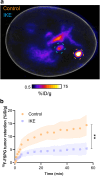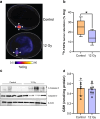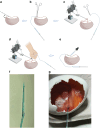The chicken chorioallantoic membrane as a low-cost, high-throughput model for cancer imaging
- PMID: 38239706
- PMCID: PMC7615542
- DOI: 10.1038/s44303-023-00001-3
The chicken chorioallantoic membrane as a low-cost, high-throughput model for cancer imaging
Abstract
Mouse models are invaluable tools for radiotracer development and validation. They are, however, expensive, low throughput, and are constrained by animal welfare considerations. Here, we assessed the chicken chorioallantoic membrane (CAM) as an alternative to mice for preclinical cancer imaging studies. NCI-H460 FLuc cells grown in Matrigel on the CAM formed vascularized tumors of reproducible size without compromising embryo viability. By designing a simple method for vessel cannulation it was possible to perform dynamic PET imaging in ovo, producing high tumor-to-background signal for both 18F-2-fluoro-2-deoxy-D-glucose (18F-FDG) and (4S)-4-(3-18F-fluoropropyl)-L-glutamate (18F-FSPG). The pattern of 18F-FDG tumor uptake were similar in ovo and in vivo, although tumor-associated radioactivity was higher in the CAM-grown tumors over the 60 min imaging time course. Additionally, 18F-FSPG provided an early marker of both treatment response to external beam radiotherapy and target inhibition in ovo. Overall, the CAM provided a low-cost alternative to tumor xenograft mouse models which may broaden access to PET and SPECT imaging and have utility across multiple applications.
Conflict of interest statement
Competing Interests The authors declare no competing interests.
Figures







Similar articles
-
In vivo PET/CT in a human glioblastoma chicken chorioallantoic membrane model: a new tool for oncology and radiotracer development.J Nucl Med. 2013 Oct;54(10):1782-8. doi: 10.2967/jnumed.112.117150. Epub 2013 Aug 22. J Nucl Med. 2013. PMID: 23970367
-
Radiotracer stereochemistry affects substrate affinity and kinetics for improved imaging of system xC- in tumors.Theranostics. 2022 Jan 24;12(4):1921-1936. doi: 10.7150/thno.63237. eCollection 2022. Theranostics. 2022. PMID: 35198080 Free PMC article.
-
(4S)-4-(3-18F-fluoropropyl)-L-glutamate for imaging of xC transporter activity in hepatocellular carcinoma using PET: preclinical and exploratory clinical studies.J Nucl Med. 2013 Jan;54(1):117-23. doi: 10.2967/jnumed.112.108704. Epub 2012 Dec 11. J Nucl Med. 2013. PMID: 23232273
-
(4S)-4-(3-[18F]Fluoropropyl)-l-glutamate.2013 Mar 20 [updated 2013 May 23]. In: Molecular Imaging and Contrast Agent Database (MICAD) [Internet]. Bethesda (MD): National Center for Biotechnology Information (US); 2004–2013. 2013 Mar 20 [updated 2013 May 23]. In: Molecular Imaging and Contrast Agent Database (MICAD) [Internet]. Bethesda (MD): National Center for Biotechnology Information (US); 2004–2013. PMID: 23700646 Free Books & Documents. Review.
-
Critical appraisal of the chorioallantoic membrane model for studying angiogenesis in preclinical research.Mol Biol Rep. 2024 Sep 28;51(1):1026. doi: 10.1007/s11033-024-09956-x. Mol Biol Rep. 2024. PMID: 39340708 Review.
Cited by
-
Preclinical evaluation of the potential PARP-imaging probe [carbonyl-11C]DPQ.EJNMMI Radiopharm Chem. 2025 Jan 10;10(1):1. doi: 10.1186/s41181-024-00323-6. EJNMMI Radiopharm Chem. 2025. PMID: 39792304 Free PMC article.
-
Exploring the Chorioallantoic Membrane (CAM) as a Platform for Burn Wound Modelling and Analysis.Methods Protoc. 2025 Jul 10;8(4):79. doi: 10.3390/mps8040079. Methods Protoc. 2025. PMID: 40700317 Free PMC article.
-
[18F]FSPG-PET provides an early marker of radiotherapy response in head and neck squamous cell cancer.Npj Imaging. 2024;2(1):28. doi: 10.1038/s44303-024-00038-y. Epub 2024 Aug 9. Npj Imaging. 2024. PMID: 39132311 Free PMC article.
-
Vascularised organoids: Recent advances and applications in cancer research.Clin Transl Med. 2025 Mar;15(3):e70258. doi: 10.1002/ctm2.70258. Clin Transl Med. 2025. PMID: 40045486 Free PMC article.
-
Methodology for generating chorioallantoic membrane patient-derived xenograft (CAM-PDX) models of pleural mesothelioma and performing preclinical imaging for the translation of cancer studies and drug screening.F1000Res. 2025 Aug 14;14:481. doi: 10.12688/f1000research.163596.2. eCollection 2025. F1000Res. 2025. PMID: 40568242 Free PMC article.
References
Grants and funding
LinkOut - more resources
Full Text Sources
